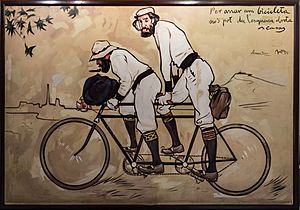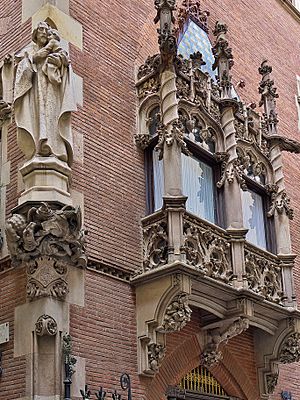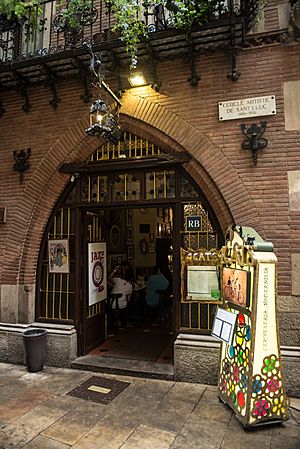Els Quatre Gats facts for kids
Els Quatre Gats (which means "The Four Cats" in Catalan) is a famous café in Barcelona, Catalonia, Spain. It became a very popular meeting spot for important artists during the Modernist period in Catalonia, known as Modernisme. The café first opened its doors on June 12, 1897. It was located in the well-known Casa Martí building.
At first, it was a hostel, a bar, and a place for shows. Soon, it became a central place for Barcelona's most famous Modernist artists. People like Pablo Picasso and Ramon Casas i Carbó often met there. The café closed in June 1903 because of money problems. But it was reopened later and fully restored in 1989.
Contents
History of the Café
The idea for Els Quatre Gats came from Pere Romeu. He was inspired by a French café called Le Chat Noir (The Black Cat), where he used to work. The name "Els Quatre Gats" means "The Four Cats." This comes from a Catalan saying that describes a small group of people who are a bit unusual or different. Romeu loved the Parisian café and wanted his own café to look similar.
Three of Romeu's friends helped him with money. They were Ramon Casas i Carbó, Santiago Rusiñol, and Miguel Utrillo. These were all major Modernist Spanish artists. Casas even painted a special picture for the café's inside walls. It was his famous painting called Ramon Casas and Pere Romeu on a Tandem. The painting shows Casas and Romeu riding a bike together. The Barcelona skyline is in the background. A message on the painting says, "To ride a bike, you can't go with your back straight." This means that to make great things happen, you sometimes need to break old rules. The original painting is now in a museum. A copy hangs in the café today.
A Place for Artists
The café opened on June 12, 1897, inside Casa Martí. This was an important Modernist building designed by the architect Josep Puig i Cadafalch. The four founders wanted the café to be known for more than just good food and drinks. Rusiñol said they wanted "food of the spirit." This meant a place where artists could meet, talk about their work, and share news. The bar also featured piano music. It quickly became a favorite spot for important Modernist and bohemian artists. This included Casas and Rusiñol, as well as architects like Antoni Gaudí and sculptors like Julio González.
As the café grew more popular, it hosted many other thinkers from Barcelona's new Modernist scene. They came for performances, concerts, art shows, and literary meetings. In 1899, when he was just 17 years old, Pablo Picasso started visiting Els Quatre Gats often. He even held his first solo art show in the main room. The poster you see outside the café today was designed by Picasso himself.

Closing and Reopening
Sadly, Pere Romeu was not a very good businessman. He often let his friends order food at lower prices, or sometimes even for free. Because of this, Els Quatre Gats went out of business in June 1903.
However, the café's spirit lived on. Ramon Casas and Miguel Utrillo kept writing a literary magazine inspired by the café. They continued this for five years after the café closed. After Francisco Franco died and Spain became a democracy in the 1970s, three business people worked to restore the café. Their names were Pere Moto, Ricard Alsina, and Ana Verdeguer. They argued that bringing the café back would help Barcelona's culture. This was very important after the difficult times Catalonia had faced under Franco. In 1978, the famous café finally reopened to the public. Casa Martí, the building it is in, was fully restored in 1991.
Famous Visitors
- Gustavo Barceló (book lover)
- Ramon Casas (artist)
- Santiago Rusiñol (artist)
- Rubén Dario (poet)
- Pablo Picasso (artist)
- Isaac Albéniz (pianist and composer)
- Enric Granados (pianist and composer)
- Lluís Millet (musician and composer)
- Antoni Gaudí (architect)
- Ricard Opisso (cartoonist, illustrator, and painter)
- Miquel Utrillo (artist)
- Julio González (sculptor)
- Lluïsa Vidal (artist)
Modernist Style of the Building

Els Quatre Gats is on the ground floor of the famous Modernist building called Casa Martí. Josep Puig i Cadafalch designed it in 1896. The café looks a bit like it's in a medieval castle. The front of the building, where the entrance is, takes ideas from the European Gothic style. The overall look of the building seems more Northern European than typical Catalan.
However, the building is decorated with classic elements of Catalan Art-Nouveau, also known as Catalan Modernism. These include the iron details, the colorful stained glass windows, and the sculptures on the corner of the building. Manuel Ballerín created the beautiful ironwork. Eusebi Arnau, a famous Barcelona sculptor, made the story-telling sculptures on the capitals (tops of columns). The sculpture of Saint Joseph was made by Josep Llimona, another well-known Spanish sculptor. Sadly, the statue of Saint Joseph you see today is a copy. The original was destroyed during the Spanish Civil War.
The building's balconies were designed in the Catalan Art-Nouveau style. This is the name given to the Modernist movement in Barcelona and Catalonia. You can also see this style in the stained glass windows. These windows are set within large, pointed arches, which are typical of Gothic architecture. The furniture inside the building was paid for by Ramón Casas. It has a medieval style, not a Modernist one.
The mix of all these different styles makes Casa Martí an amazing example of Modernist architecture. It combines Gothic, medieval, and many Catalan Art-Nouveau elements on its facade. The building was officially recognized as an "Asset of Natural Cultural Interest" on January 9, 1976.
The Literary Magazine
In 1899, a literary magazine with the same name as the café was published for the first time. This magazine included articles from many different Modernist artists. Most of them were written by two of the café's founders, Ramon Casas and Miguel Utrillo.
The magazine, just like the café, was inspired by Le Chat Noir. It became an important platform for Catalan Modernism in art and writing. The main goal of this magazine was to tell the people of Barcelona about the ideas of the Modernist artists. It also talked openly about their artworks. The articles in the magazine were both serious and funny. Most of them aimed to explain and defend the Modernists' art to the public.
After only fifteen issues, the "Els Quatre Gats" magazine stopped. But a new magazine, Pel y Ploma (meaning Hair and Feather), continued its tradition. Pel y Ploma ran from 1899 until 1903. Then, a third magazine called Forma took its place. Ramon Casas and Miguel Utrillo kept writing for these two new magazines. This helped keep the café's legacy alive even after it closed. The third magazine, Forma, did not get enough readers and ended in 1908.
See also
 In Spanish: Els Quatre Gats para niños
In Spanish: Els Quatre Gats para niños


